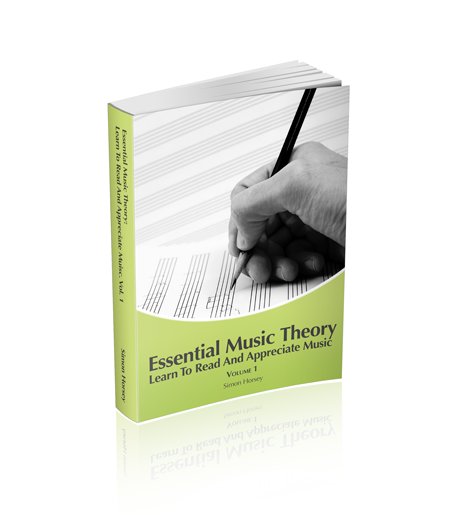"AT LAST...An Easier Way To
Learn Music Theory!"
Learning to read music really is easier than you think, and with clear explanations of concepts and interactive reviews to support your learning, Essential Music Theory helps you every step of the way.
Are you or your child frustrated with learning to read music?
Fed up of not being able to complete those theory questions?
Does music seem too complicated?
Do you want an easier, more effective method for learning music theory?
You Are In Luck!
There’s finally a book available that provides instruction using a variety of learning methods to ensure all learners are able to understand the basics of music theory. Essential Music Theory: Learn To Read And Appreciate Music, Volume 1, is the premier learning tool for anyone who wants to excel in music.

Hello, my name is Simon Horsey, welcome to my website. For the past 15 years I have been been teaching music to both class and individual students. I give them a solid grounding in music theory and also show them how to pass their theory exams with flying colors. I have a 100% success rate with theory exams and my latest students all passed the Royal Schools of Music (ABRSM) theory exams with Merit or Distinction.
I've already worked out the most common stumbling blocks that most people make and now I have created an eBook that teaches music theory just like I do, using actual musical examples that you can listen to which make it much easier for you and teach you how to understand music theory.
Volume 1 takes you through the elements of music: how to read music in both G (treble) and F (bass) clefs, teaches you the US and UK note names, basic intervals, how to write major and minor scales, basic composition technique using rhythm, time signatures and performance directions.
This book contains everything you need to help you pass your early level theory exams, including ABRSM Grade 1 and 2 theory.
Instead of learning facts by rote each concept is clearly explained with musical examples and helpful hints for remembering and applying what you have learned. The book is written in a light, easy to read style and is suitable for class or individual study.
There are overview Mindmaps at the start of each chapter and clear learning intentions for each section, as well as many end of unit quizzes built right into the book itself. Yes, you or your students can take a review quiz and have the answers checked with no internet connect needed!
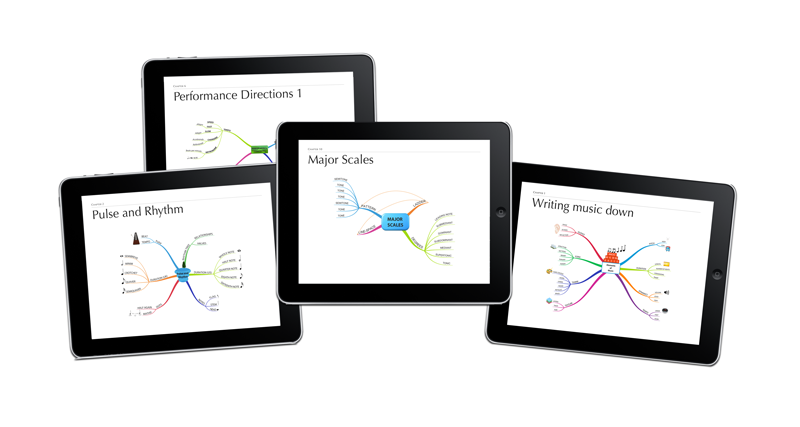 Mindmaps give an overview of each chapter
Mindmaps give an overview of each chapterREAD THESE COMMENTS ABOUT ESSENTIAL MUSIC THEORY.
“I would definitely recommend this book to other parents in a heartbeat.” - Victoria
“Thanks to this book, I now have a solid understanding of music theory. It is easy enough for me to understand, and I also like that it didn’t assume I knew everything about music already, like some other books did.” - Ron Fredrick
“I’ve played by ear all my life but with Essential Music Theory I have learned to read music and so much more about how it is constructed. I’ve even done a few of my own compositions. Thank you!” - Jack
Whether you regret not learning to read music earlier, or you are just starting out in music, a good knowledge of the theory and ideas behind how music is written will improve your playing, no matter what your style.
It will also improve your sight reading, improvisation and composition! Essential Music Theory is written by a music teacher with over 20 years experience of teaching both children and adults.
A good knowledge of the theory and ideas behind how music is written will improve your playing, no matter what your style.
A good understanding of theory improves your sight reading, improvisation, composition and your playing in general.
Rock Musicians: Want to improve your soloing so you blow everybody else off the stage?
Jazz Musicians: If your theory isn't up to speed you are missing huge opportunities to impress others with your chops!
Classical Musicians: Understanding theory helps you memorise music faster and more securely, and it even makes your sight reading better!
Kids: Get to the top of the music class with easy to understand descriptions and quizzes to check your understanding.
Adults: Enjoy everything about music more when you understand the basics of how it is constructed.
Teachers: Use this with your class and you have built in differentiation! Each student can work at their own pace and complete the built in reviews at the end of each section.
Here Is A Summary Of Just SOME Of The Benefits Of Learning With Essential Music Theory
Mind Maps and overviews of each chapter mean your mind is trained on what you are going to learn
Review quizzes you can take within the book. No internet connection needed
Videos to provide demonstrations and explanations for more complex concepts
Audio files that relate the theory to the music, to help you understand. Hear the differences instead of just learning about them
Easy to read style to enable musicians of all ages to enjoy and understand everything
Clear explanations of even difficult concepts
Attractive layout promotes learning and retention
Each chapter builds on concepts covered in previous chapters
Everything you need to cover the ABRSM Grade 1 AND 2 syllabus, all in one book
Perfect for individuals or group study
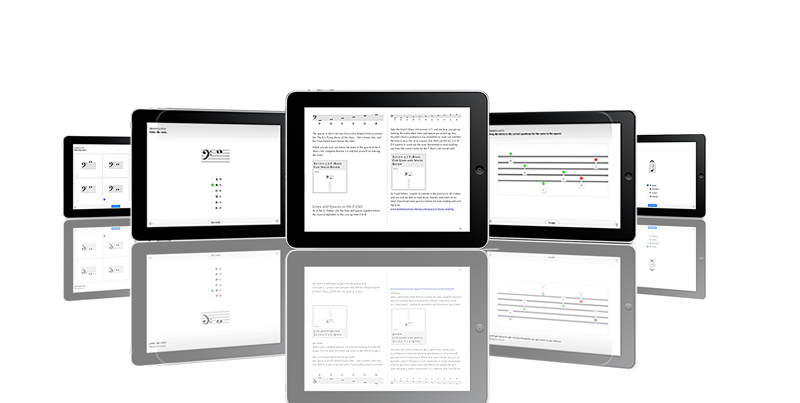
You Can Benefit From
My Years Of Teaching Experience
YOU LEARN to read music, both the Treble (G) and Bass (F) clefs using one simple technique which will also mean you can easily read the C clef later on.
YOU LEARN about the elements of music. These are the basic building blocks. Understanding them gives you a strong foundation for future understanding of all music theory yet many theory books don't even mention these!
YOU LEARN short cuts and tips to help learn and recognise key signatures more easily. Key signatures aren't as hard as some other methods lead you to believe!
YOU LEARN both US and UK note names. Why only learn one method when it is so easy to learn both and they are both useful for different things?
YOU LEARN how scales are constructed. You don't just learn the notes by rote as in some other methods. You learn a method and once you know this you know how to play almost any major or minor scale!
YOU LEARN all the musical terminology you need for ABRSM Grade 1 and 2 theory exams with helpful hints to hook the words in your memory. Did you ever wonder how to remember that pesante means heavy or ponderous? Just remember peasants dancing in hobnailed boots and wondering about the next step! That would be very heavy and ponderous dancing!
And one simple trick that will ensure you never forget the key signatures of D, A, E and B majors as long as you live!
Look At What You Are Getting
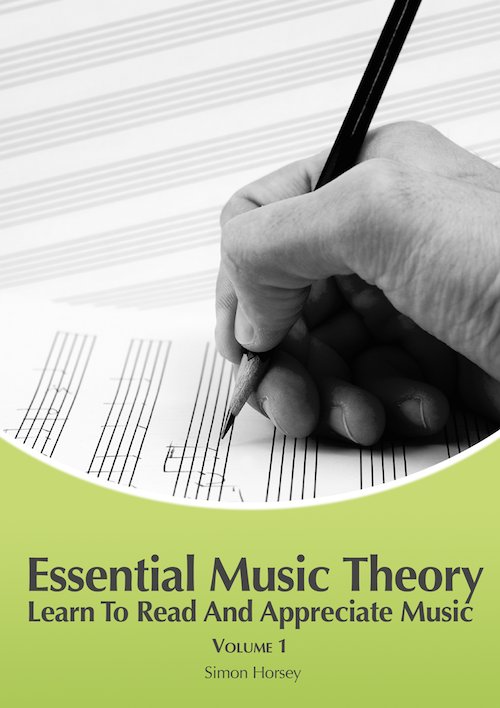
Here is the table of contents so you can see just how much is included in Volume 1! Remember this takes you right from a total beginner which is why you begin with the Elements Of Music.
This is the equivalent of Books 1 and 2 and sometimes even 3 in other courses!
Most chapters have a review quiz at the end of them. These are completed in the book with no internet connection required. Some exercises don't lend themselves to electronic completion so these can be completed on manuscript paper (downloadable free from the Essential Music Theory site) and checked the old fashioned way, answers in the back of the book!
Chapter 1: The Elements of Music
- How Music Is Written Down
- The Building Blocks Of Music
Chapter 2: Pulse And Rhythm
- What is Pulse?
- What is Rhythm?
- The Parts Of The Note
- Different Note Lengths
- The Note Names
- The Rhythm Tree
- How Many Beats?
- Dotted Notes
Chapter 3: Pitch
- The Musical Alphabet
- Lines and Spaces
- The G (Treble) Clef
- The F (Bass) Clef
- The Grand Staff and Middle C
- The Piano Keyboard
- Ledger Lines
Chapter 4: All About Time
- Measures, Bars and Bar lines
- Time Signatures
- The Anacrusis
- Rests
Chapter 5: Composing
- How To Compose An Answering Rhythm
- How To Use The Material You Are Given
- Thinking About Endings
Chapter 6: Performance Directions 1
- Dynamics
- Tempo
- Articulation
- Form
Chapter 7: Back In Time
- Ties
- Triplets
Chapter 8: Grouping
- Grouping Notes
- Grouping Dotted Notes
- Mixtures
- Grouping Rests
Chapter 9: Tones and Semitones
- Defining And Finding
- Sharps
- Flats
- Naturals
- Accidentals
- The Keyboard
Chapter 10: Major Scales
- The Pattern - Order Of Tones And Semitones
- The Degrees Of The Scale
- When To Use A Sharp Or A Flat
Chapter 11: Major Keys And Key Signatures
- Key Signatures From Scales
- Relative Keys
- The Cycle Of Fifths
- The Order Of Sharps
- The Order Of Flats
- Writing Key Signatures
Chapter 12: More About Time
- More Complex Time Signatures
- Grouping
Chapter 13: Intervals
- What Is An Interval?
- How To Count Intervals
- How To Write Intervals
Chapter 14: Minor Scales
- Relative Minors
- The Natural Minor
- The Harmonic Minor
- The Melodic Minor
- Alternative Methods For Minor Scales
Chapter 15: Tonic Triads
- Chords
- Numbering And Labelling Chords
- Root Postion Triads
Chapter 16: Performance Directions 2
- Tempo
- Dynamics
- Articulation
Answers To Written Review Questions

Don't Just Take My Word For It!
Check Out These 5* reviews from the iBooks Store
helpful ★★★★★
by No Shaffer - Feb 5, 2015
Though there is no substitute for live teacher-student teaching, this book gives a well rounded introduction to the fundamentals of reading music. It offers many useful activities to build one's understanding of notes. The quizzes concept is fun & very helpful too
short cuts and tips ★★★★★
by Shar Patter - Feb 6, 2015
Gaining an understanding of how to read the notes and symbols on sheet music is extremely beneficial to one's musical development. This book does just that. It is also full of short cuts and tips to teach you recognise key signatures more easily
An easy way to learn the basics of music theory ★★★★★
by SaraH.36 - Jan 11, 2015
My son is learning to play the piano but I had never play an instrument in my life. Every time he had a question I could see his face wondering why is he learning music theory if I never had to. After he challenged me to learn with him, I've attempted to read many theory books and this is the first one that makes sense. The simple way this book is presented makes it enjoyable and I am finally getting a clear idea on how to read music. I love the fact that this book allows me to hear musical examples so I can better understand the concepts. I highly recommend!
...and more on the iBooks Store!
Get it before the price goes up!
Essential Music Theory Volume 1: Learn To Read An Appreciate Music is currently priced $9.99 in the iBooks Store. This is is less than one single music theory lesson with a teacher!
But it won't stay at this price forever! I am currently updating the book with new videos and audio files to make learning music theory even easier!
Once I have finished updating the book THE PRICE WILL GO UP.
However, once you have bought a book from the iBooks Store Apple GUARANTEES you will have FREE UPDATES FOR THE LIFE OF THE BOOK.
This means that if you buy now, you will have all the benefits of the updated book with nothing extra to pay!
Click below and ORDER NOW on the iBooks Store. Banish your music theory problems for good!
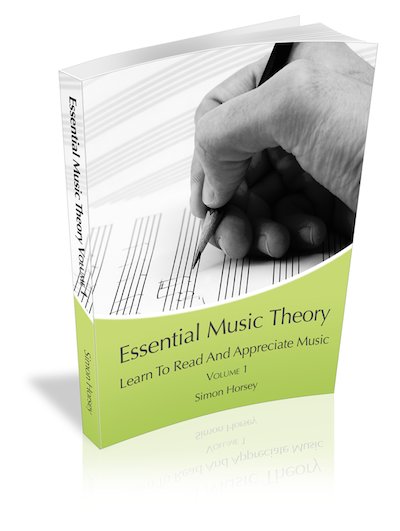
And If You Are Still Not Convinced...
Look at these mark sheets for the Grade 5 Associated Board of the Royal Schools of Music (ABRSM) exams in the UK. These are my students, two of whom only studied theory for 3 months. They all used the methods in my book, so if you want the chance to succeed in music and theory just like they did go to the iBooks Store and order Essential Music Theory Volume 1 NOW!
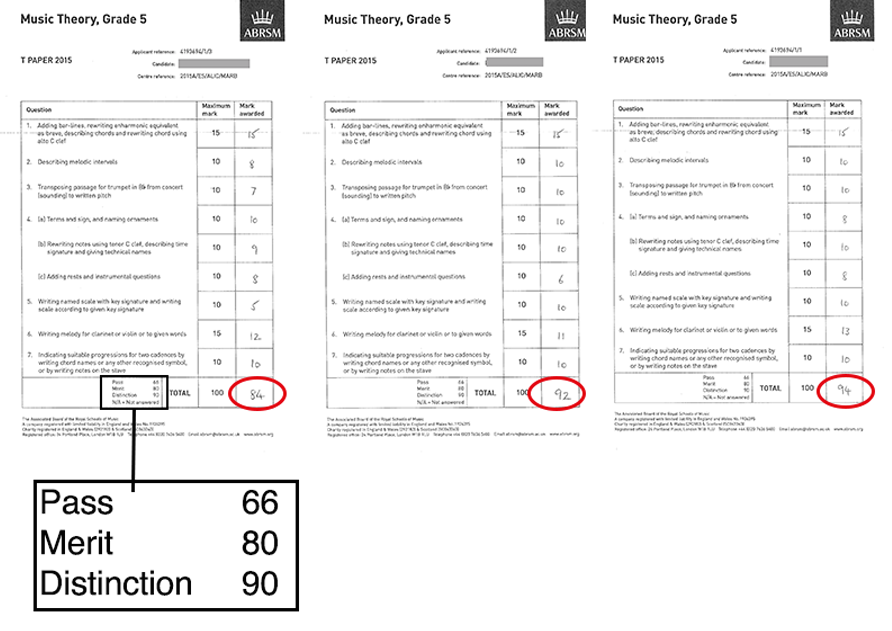 A Merit and 2 Distinctions for my students
A Merit and 2 Distinctions for my students